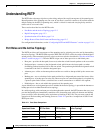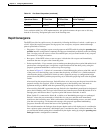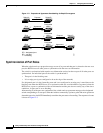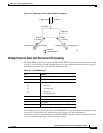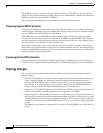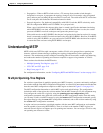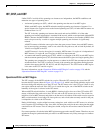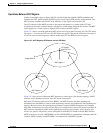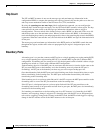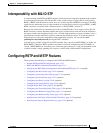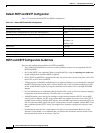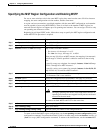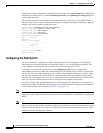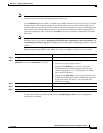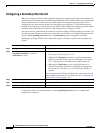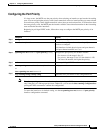
12-10
Catalyst 2950 Desktop Switch Software Configuration Guide
78-14982-01
Chapter 12 Configuring RSTP and MSTP
Understanding MSTP
Hop Count
The IST and MST instances do not use the message-age and maximum-age information in the
configuration BPDU to compute the spanning-tree topology. Instead, they use the path cost to the root
and a hop-count mechanism similar to the IP time-to-live (TTL) mechanism.
By using the spanning-tree mst max-hops global configuration command, you can configure the
maximum hops inside the region and apply it to the IST and all MST instances in that region. The hop
count achieves the same result as the message-age information (determines when to trigger a
reconfiguration). The root switch of the instance always sends a BPDU (or M-record) with a cost of 0
and the hop count set to the maximum value. When a switch receives this BPDU, it decrements the
received remaining hop count by one and propagates this value as the remaining hop count in the BPDUs
it generates. When the count reaches zero, the switch discards the BPDU and ages the information held
for the port.
The message-age and maximum-age information in the RSTP portion of the BPDU remain the same
throughout the region, and the same values are propagated by the region’s designated ports at the
boundary.
Boundary Ports
A boundary port is a a port that connects an MST region to a single spanning-tree region running RSTP,
or to a single spanning-tree region running 802.1D, or to another MST region with a different MST
configuration. A boundary port also connects to a LAN, the designated switch of which is either a single
spanning-tree switch or a switch with a different MST configuration.
At the boundary, the roles of the MST ports do not matter, and their state is forced to be the same as the
IST port state (MST ports at the boundary are in the forwarding state only when the IST port is
forwarding). An IST port at the boundary can have any port role except a backup port role.
On a shared boundary link, the MST ports wait in the blocking state for the forward-delay time to expire
before transitioning to the learning state. The MST ports wait another forward-delay time before
transitioning to the forwarding state.
If the boundary port is on a point-to-point link and it is the IST root port, the MST ports transition to the
forwarding state as soon as the IST port transitions to the forwarding state.
If the IST port is a designated port on a point-to-point link and if the IST port transitions to the
forwarding state because of an agreement received from its peer port, the MST ports also immediately
transition to the forwarding state.
If a boundary port transitions to the forwarding state in an IST instance, it is forwarding in all MST
instances, and a topology change is triggered. If a boundary port with the IST root or designated port
role receives a topology change notice external to the MST cloud, the MSTP switch triggers a topology
change in the IST instance and in all the MST instances active on that port.



